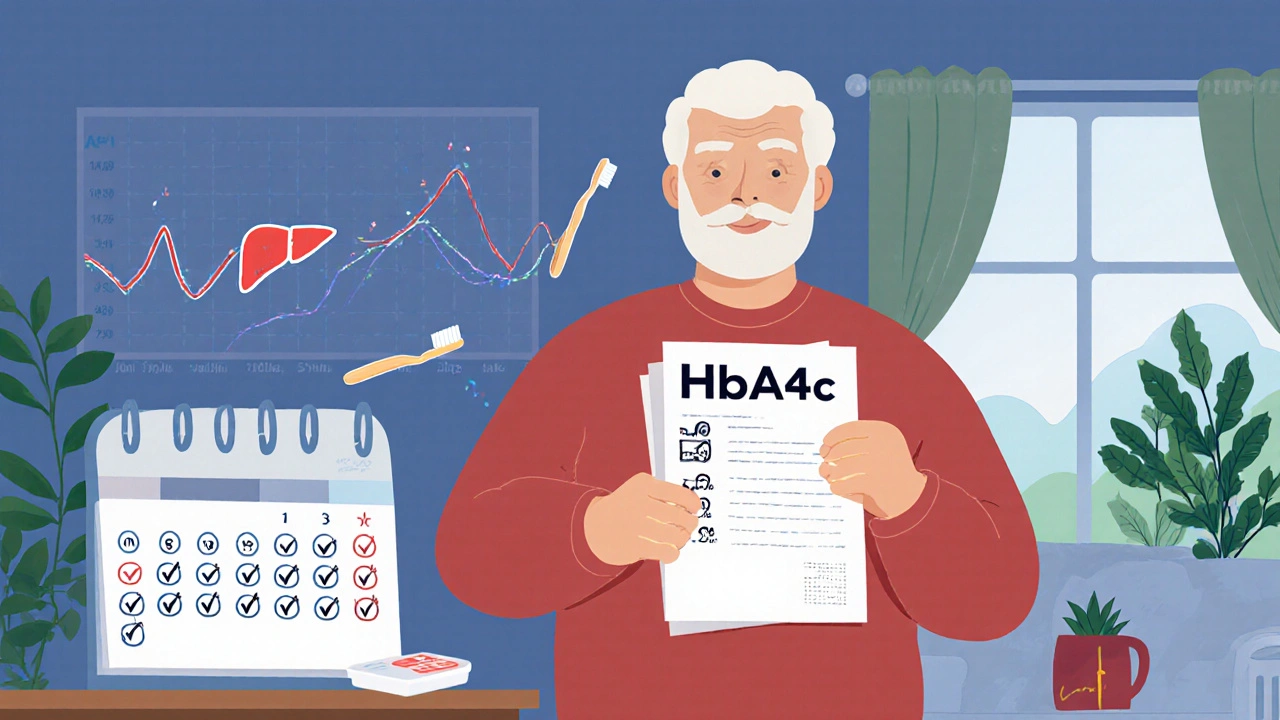Rybelsus is the first and only oral GLP-1 receptor agonist approved for treating type 2 diabetes in adults. Unlike most diabetes medications that require injections, Rybelsus comes as a pill you swallow. It’s not a quick fix, but for many people, it’s a game-changer-especially if you’ve struggled with daily insulin shots or dislike needles.
How Rybelsus Works
Rybelsus contains semaglutide, the same active ingredient found in Ozempic, but designed to survive digestion so it can be taken by mouth. Once absorbed, it mimics a natural hormone called GLP-1 (glucagon-like peptide-1) that your body releases after eating. This hormone tells your pancreas to make more insulin when blood sugar rises, and it slows down how fast your stomach empties. That means you feel full longer, eat less, and your blood sugar stays more stable.
It also reduces the amount of glucose your liver releases between meals. For people with type 2 diabetes, the liver often overproduces sugar-even when it’s not needed. Rybelsus helps fix that. Studies show it lowers HbA1c (a measure of average blood sugar over 3 months) by about 1.0% to 1.5% on average, which is comparable to many injectable diabetes drugs.
Who Should Take Rybelsus
Rybelsus isn’t for everyone. It’s approved only for adults with type 2 diabetes-not type 1, not for weight loss alone, and not for people with a personal or family history of medullary thyroid cancer or Multiple Endocrine Neoplasia syndrome type 2. If you’ve had pancreatitis, you should talk to your doctor first.
It’s often prescribed when metformin isn’t enough, or when someone wants to avoid injections. Many patients choose Rybelsus because they’re tired of daily insulin pens or weekly GLP-1 shots. It’s also a good option if you’re trying to lose weight, since many users report losing 5-10% of their body weight over six months. That’s not just cosmetic-it improves blood pressure, cholesterol, and reduces strain on joints and the heart.
Dosing and How to Take It Right
Rybelsus comes in three strengths: 3 mg, 7 mg, and 14 mg. You start at 3 mg once daily for the first 30 days. That’s low on purpose-your body needs time to adjust. After a month, your doctor will likely increase it to 7 mg. If you still need better blood sugar control after another 30 days, you may move up to 14 mg.
Here’s the tricky part: you must take it on an empty stomach, first thing in the morning, with no more than 4 ounces of plain water. You can’t eat, drink anything else (not even coffee), or take other oral meds for at least 30 minutes after. If you miss a dose, skip it. Don’t double up the next day. This strict routine is because food, drinks, or other medications can block absorption and make the drug useless.
Most people find this hard at first. But once it becomes part of your morning routine-take it before brushing your teeth, before making breakfast-it gets easier. One patient in Bristol told me she keeps her pills in a small box next to her toothbrush. That’s the kind of habit that sticks.
Side Effects and Risks
The most common side effects are nausea, vomiting, diarrhea, and stomach pain. These usually fade after a few weeks as your body adjusts. Taking it slowly (starting at 3 mg) helps reduce these. If nausea lasts longer than a month, talk to your doctor-you might need a slower ramp-up or a different option.
More serious, but rare, risks include pancreatitis (severe belly pain that doesn’t go away), gallbladder problems, and kidney issues. There’s also a boxed warning about thyroid tumors in animal studies. While no human cases have been confirmed, it’s why people with certain thyroid conditions are told to avoid it.
Some users report dizziness or low blood sugar, especially if they’re also taking insulin or sulfonylureas. That’s why your doctor will likely adjust those other meds when you start Rybelsus.

Cost and Accessibility
Rybelsus is expensive. In the UK, without insurance, a 30-day supply costs around £250-£300. That’s why it’s not usually a first-line treatment. The NHS typically prescribes it only after metformin and other oral meds have failed, or if you have obesity and need weight loss support.
Some private insurers cover it, and Novo Nordisk (the maker) offers patient assistance programs. You can check their website for discounts or coupons. In the U.S., the list price is over $1,000 a month, but with coupons, many pay under $300. In the UK, access is more restricted, but it’s available on prescription if your consultant agrees it’s right for you.
Rybelsus vs Other Diabetes Treatments
How does it stack up against other options? Here’s a quick comparison:
| Medication | Form | Typical HbA1c Reduction | Weight Change | Dosing Frequency |
|---|---|---|---|---|
| Rybelsus | Oral pill | 1.0%-1.5% | 5-10% loss | Daily |
| Metformin | Oral pill | 0.5%-1.0% | Mild loss or neutral | Twice daily |
| Ozempic (semaglutide injection) | Weekly injection | 1.3%-1.8% | 5-12% loss | Weekly |
| Insulin glargine | Daily injection | 1.0%-1.5% | Weight gain | Daily |
| SGLT2 inhibitors (e.g., Jardiance) | Oral pill | 0.5%-1.0% | 2-5% loss | Daily |
Rybelsus sits between metformin and injectable GLP-1s like Ozempic. It’s not quite as strong as the weekly shot, but it’s much more convenient than daily injections. If you’re choosing between Rybelsus and Jardiance (an SGLT2 inhibitor), Rybelsus usually gives better HbA1c control and more weight loss. But Jardiance has proven heart and kidney protection benefits that Rybelsus doesn’t yet have in the same way.
What to Expect in the First Few Weeks
Week 1-2: You might feel queasy. Skip the greasy breakfast. Stick to toast or oatmeal. Drink water slowly. Don’t panic if your appetite drops-that’s normal.
Week 3-4: Nausea should fade. You might notice your snacks aren’t as tempting. Your morning blood sugar readings may start to drop. Keep logging them.
Week 5-8: If you’re on 7 mg, you’ll start seeing clearer trends. Many people report feeling more energetic. Sleep improves. Cravings for sugar go down.
By month three, if you’re sticking with it, your HbA1c should be on a downward path. That’s when you and your doctor decide whether to stay at 7 mg or move to 14 mg.

When Rybelsus Isn’t the Right Choice
It’s not for people who:
- Have type 1 diabetes
- Have a history of thyroid cancer or MEN2
- Can’t commit to taking it on an empty stomach every morning
- Have severe digestive disorders like gastroparesis
- Are pregnant or planning to get pregnant
If you’ve tried metformin and it gave you terrible stomach issues, Rybelsus might be harder to tolerate. Some people with IBS find it triggers bloating and cramps. If you’re allergic to semaglutide or any of its ingredients, don’t take it.
And if your goal is rapid weight loss? Rybelsus isn’t Ozempic for weight loss. While many lose weight, it’s not FDA-approved for that purpose. For that, Wegovy (a higher-dose version of semaglutide) exists-but it’s an injection.
Real-Life Impact
One 58-year-old man from Bristol, who had been on insulin for 8 years, switched to Rybelsus after his doctor suggested it. He hated the needles and was gaining weight. After three months on 7 mg, his HbA1c dropped from 8.4% to 6.8%. He lost 14 pounds. He stopped using insulin. He says the hardest part was remembering to wait 30 minutes after taking it-but now he doesn’t even think about it. "It’s just part of my morning," he told me. "Like brushing my teeth."
Another woman, 63, with kidney disease, was advised against Rybelsus because of her low kidney function. Her doctor chose a different GLP-1 that’s safer for kidneys. Not everyone gets the same option. Your health history matters.
Next Steps
If you’re considering Rybelsus:
- Talk to your GP or diabetes specialist. Ask if your HbA1c and weight make you a good candidate.
- Ask about cost and whether your insurance or NHS pathway covers it.
- Be honest about your ability to follow the strict dosing rules.
- Keep a log of your blood sugar and appetite changes for your next appointment.
- Don’t rush. It takes time to see results-and to adjust to side effects.
If you’re already taking it, don’t stop suddenly. Talk to your doctor before making any changes. Your body adapts to it. Stopping abruptly could cause your blood sugar to spike.
Is Rybelsus the same as Ozempic?
They contain the same active ingredient-semaglutide-but they’re not the same. Ozempic is an injection given once a week. Rybelsus is a daily pill. The pill form is designed to survive stomach acid and be absorbed in the intestines. The injection delivers a higher dose directly into the bloodstream. That’s why Ozempic often lowers HbA1c more and leads to more weight loss. But Rybelsus is the only oral option in its class.
Can I take Rybelsus with metformin?
Yes, many people take both. Metformin helps reduce liver glucose production and improves insulin sensitivity. Rybelsus boosts insulin after meals and slows digestion. Together, they work in different ways to control blood sugar. Your doctor will likely lower your metformin dose if you start having low blood sugar.
Does Rybelsus cause weight loss?
Yes, but it’s not guaranteed. Clinical trials show most people lose between 5% and 10% of their body weight over 6-12 months. That’s about 8-16 pounds for someone weighing 160 pounds. The weight loss comes from reduced appetite and slower digestion. It’s not a magic pill-it works best when paired with healthy eating and movement.
What happens if I forget to take Rybelsus?
If you miss a dose, skip it. Don’t take two pills the next day. Just resume your regular schedule. Missing one day won’t wreck your progress, but missing several can make your blood sugar harder to control. Try setting a daily alarm labeled "Rybelsus time"-right after you wake up, before anything else.
Can I drink coffee with Rybelsus?
No. You must wait at least 30 minutes after taking Rybelsus before drinking anything other than plain water. Coffee, tea, juice, or even sparkling water can interfere with how the drug is absorbed. Many people find it easier to take it right after waking up, before making their morning drink.
